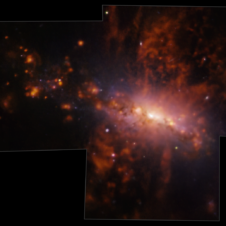Scientists have created a detailed map of the Milky Way using two of the world’s largest fully steerable radio telescopes in Germany and Australia.
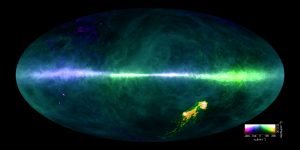
This HI4PI map was produced using data from the 100 metre Max-Planck radio telescope in Effelsberg, Germany and the 64 metre CSIRO radio telescope in Parkes, Australia. Image credit: Benjamin Winkel and the HI4PI collaboration.
The research looked at neutral atomic hydrogen—the most abundant element in space and the main component of stars and galaxies—across the whole sky in a survey known as HI4PI.
The project required more than a million individual observations and about ten billion individual data points.
University of Bonn astronomer Dr Juergen Kerp said although neutral hydrogen is fairly easy to detect with modern radio telescopes, mapping the whole sky is a significant achievement.
“Radio ‘noise’ caused by mobile phones and broadcast stations pollute the faint emissions coming from stars and galaxies in the Universe,” he said.
“So sophisticated computer algorithms have to be developed to clean each individual data point of this unwanted human interference.
“Next to the thousands of observing hours an even larger amount of time has been spent creating the final scientific data product released today.”
The HI4PI survey used CSIRO’s Parkes Observatory and the Effelsberg 100m Radio Telescope operated by the Max-Planck Institute for Radio Astronomy.
It improves the previous neutral hydrogen study, the Leiden-Argentine-Bonn (LAB) survey, by a factor of two in sensitivity and a factor of four in angular resolution.
Professor Lister Staveley-Smith, from the International Centre for Radio Astronomy Research, said the study reveals fine details of structures between stars in the Milky Way for the first time.
“These structures had been smeared out by the coarse sampling of the sky in the LAB survey,” he said.
“Pilot studies of the HI4PI data show a wealth of filamentary structures never seen before.
“Tiny clouds become visible that appear to have fuelled star formation in the Milky Way for billions of years.
“These objects are too dim and too small to be detected even in the other galaxies closest to us.”
Dr Benjamin Winkel, from the Max Planck Institute for Radio Astronomy, said having a clearer picture of the hydrogen in the Milky Way would also help astronomers to explore galaxies even at cosmological distances.
“Like the clouds at the sky, all observations we receive from the distant Universe have to pass through hydrogen in our own Milky Way,” he said.
“The HI4PI data allows us to correct accurately for all these hydrogen clouds and clean the window we are watching through.”
The research has been published today in the journal Astronomy and Astrophysics.
HI4PI data will be freely available to scientists around the world through the Strasbourg astronomical data centre.
PUBLICATION DETAILS
‘HI4PI: A full-sky Hi survey based on EBHIS and GASS’, published in the Astronomy and Astrophysics Journal October 20th, 2016.
Click here for the research paper
MORE INFORMATION
The name ‘HI4PI’ is drawn from the fact that this study measures radio wavelength radiation emitted from neutral atomic hydrogen atoms (HI) across the entire sky. Observing in all directions for an ‘all-sky’ survey in this way creates a sphere of data, and because the solid angle (a two-dimensional analogue of an angle) of a sphere is equal to 4π ’steradians’ (or square radians), we chose the name HI4PI for this work.
The International Centre for Radio Astronomy Research (ICRAR) is a joint venture between Curtin University and The University of Western Australia with support and funding from the State Government of Western Australia.
The Argelander Institut fuer Astronomy (AIfA) is an academic, research and educational institute and a part of the Department of Physics and Astronomy at the University of Bonn, Germany. The institute conducts cutting-edge research over a broad range of theoretical and observational topics from stars to cosmology.
The Max-Planck-Institut fuer Radioastronomie main area of research is radio astronomy but the activities of the institute encompass the whole area of astronomical observations throughout the electromagnetic spectrum.
CONTACT INFORMATION
Professor Lister Staveley-Smith (University of Western Australia, ICRAR)
E: Lister.Staveley-Smith@icrar.org
M: +61 425 212 592
Dr Juergen Kerp (Argelander Institute for Astronomy, University of Bonn, Germany)
E: jkerp@astro.uni-bonn.de
M: +49 228 73 3667
Dr. Benjamin Winkel (Max Planck Institute for Radio Astronomy)
E: bwinkel@mpifr.de
M: +49 225 73 01167
Pete Wheeler, Media Contact, ICRAR
E: pete.wheeler@icrar.org
M: +61 423 982 018
MULTIMEDIA
Using real data, this animation shows radio emission from neutral hydrogen atoms located in our galaxy, the Milky Way, and our neighbouring dwarf galaxies, the Large and Small Magellanic Clouds. It has been produced using observations made with the 100 metre Max-Planck radio telescope in Effelsberg, Germany and the 64 metre CSIRO radio telescope in Parkes, Australia. The colours reflect the approaching (purple/blue) and receding (orange/green)hydrogen gas motion while the brightness traces its amount. Credit: Lister Staveley-Smith, Benjamin Winkel and the HI4PI collaboration.
This animation shows the HI 21-cm line emission of neutral atomic hydrogen of the Milky Way galaxy and the neighbouring galaxies, like the Andromeda galaxy and the Magellanic Clouds, both visible in the lower half of the panel. It has been derived from observational data of the 100-m Effelsberg radio telescope operated by the Max-Planck-Institut für Radioastronomie/Germany and the CSIRO’s 64-m radio telescope at Parkes/Australia. The animation starts at the most negative velocities (blue shifted infalling gas) and subsequently evolves to positive radial velocities (red shifted, receding gas). Credit: Benjamin Winkel for the HI4PI collaboration
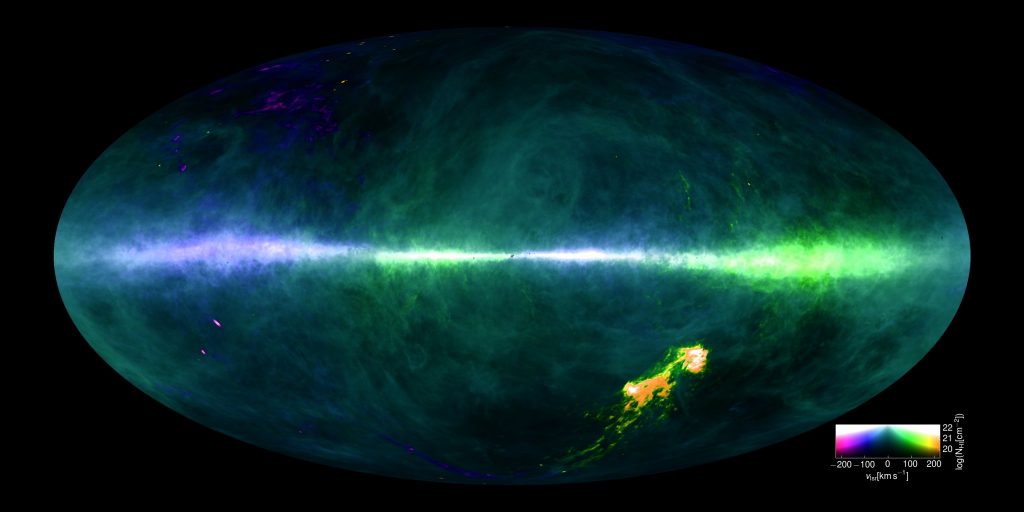
This HI4PI map was produced using data from the 100 metre Max-Planck radio telescope in Effelsberg, Germany and the 64 metre CSIRO radio telescope in Parkes, Australia. The image colours reflect gas at differing velocities. The plane of the Milky Way runs horizontally across the middle of the image. The Magellanic Clouds can be seen at the lower right. Image credit: Benjamin Winkel and the HI4PI collaboration.
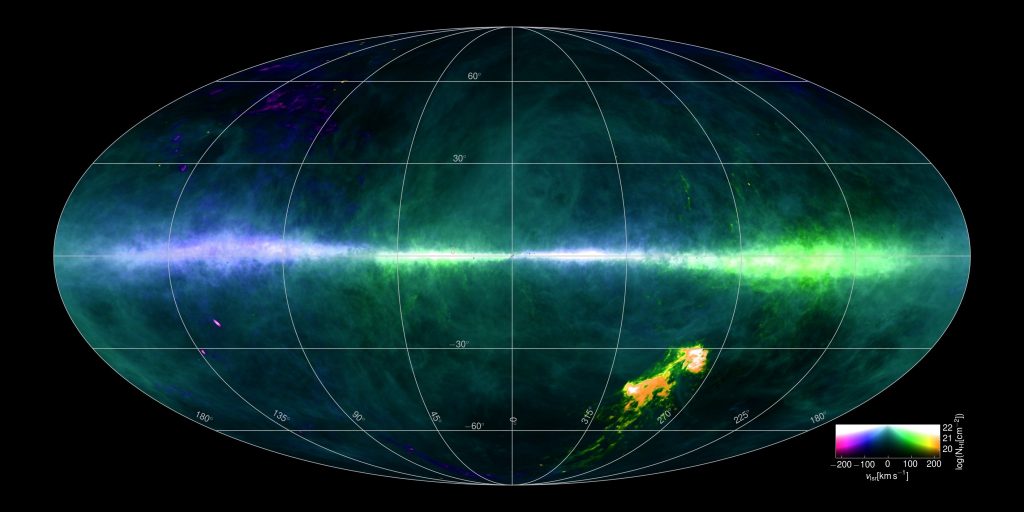
This HI4PI map was produced using data from the 100 metre Max-Planck radio telescope in Effelsberg, Germany and the 64 metre CSIRO radio telescope in Parkes, Australia. The image colours reflect gas at differing velocities. The plane of the Milky Way runs horizontally across the middle of the image. The Magellanic Clouds can be seen at the lower right. Image credit: Benjamin Winkel and the HI4PI collaboration.
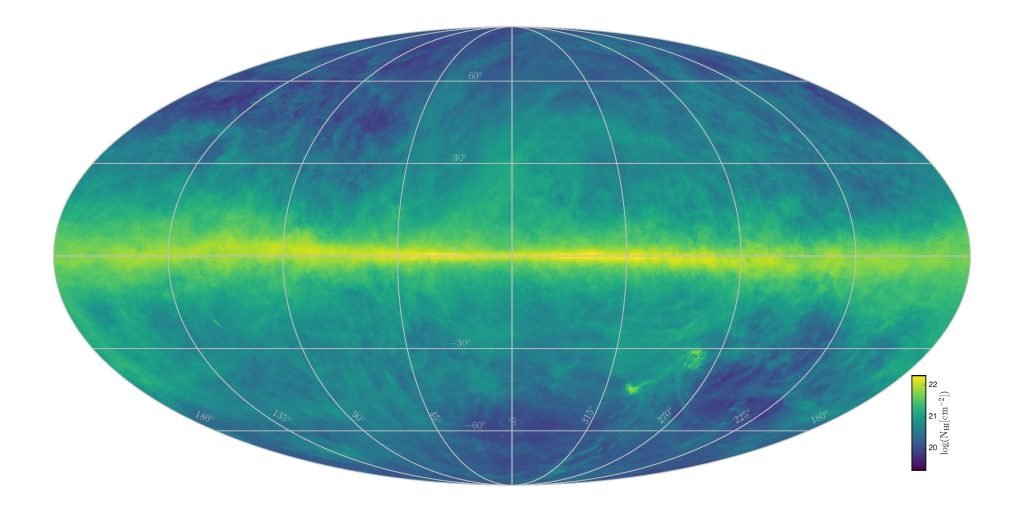
This HI4PI map was produced using data from the 100 metre Max-Planck radio telescope in Effelsberg, Germany and the 64 metre CSIRO radio telescope in Parkes, Australia. The image intensity reflects the total hydrogen content. The plane of the Milky Way runs horizontally across the middle of the image. Image credit: Benjamin Winkel and the HI4PI collaboration.
